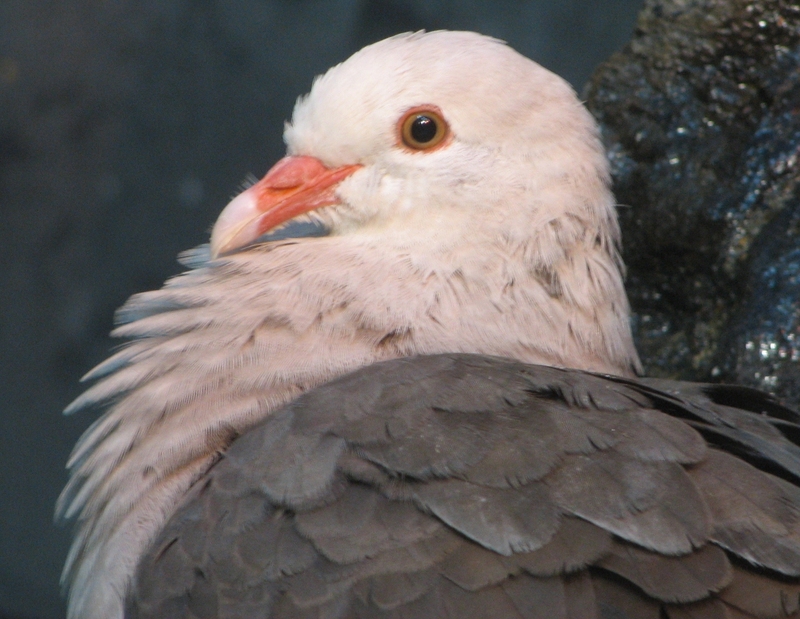Pink Pigeon (Streptopelia mayeri) - Wiki Pink Pigeon
From Wikipedia, the free encyclopedia
[Photo] Mauritius Pink Pigeon - Columba mayeri. Date March 1st, 2007. Author Ltshears - Trisha M Shears. License: public domain.
Order: Columbiformes
Family: Columbidae
Binomial names
Columba mayeri (Prevost, 1843)
Streptopelia mayeri (Johnson et al, 2001)
Nesoenas mayeri (Cheke, 2005)
The Pink Pigeon is a species of Columbidae (doves and pigeons) endemic to Mauritius, and now very rare. It has been conserved through the efforts of Gerald Durrell and the Durrell Wildlife Conservation Trust in the 1960s. The book Golden Bats and Pink Pigeons by Gerald Durrell refers to the conservation efforts. The IUCN has recently downlisted the species from critically endangered to endangered. Mauritius has brought out a series of stamps depicting the endemic Pink Pigeon.
Description
An adult pigeon is about 32 cm from beak to tail and 350 gram in weight. Pink pigeons have pale pink plumage on their head, shoulders and underside, along with pink feet and beak. They have dark brown wings, and a broad, reddish-brown tail. They have dark brown eyes surrounded by a ring of red skin.
Newly hatched pigeons have sparse, downy-white feathers and closed eyes.
Phylogeny
Initially classified as a true pigeon, it was re-classified in a monotypic genus by Tommaso Salvadori. Recent DNA analyses suggests its nearest neighbour on the phylogenetic tree is the geographically close Madagascar Turtle Dove (Streptopelia picturata), and has thus been placed in the Streptopelia genus, which mostly contains turtle doves. However, the two species form a distinct group that cannot unequivocally be assigned to either Streptopelia or Columba, and indeed, placing the two species in Nesoenas may best reflect the fact that they seem to belong to a distinct evolutionary lineage (Johnson et al., 2001). BLOBS!!
Range
It is only found in the Mascarene island of Mauritius, a related form having become extinct in the neighbouring larger Reunion Island.
On Mauritius, it is found in patches of forest in the Southwest.
Habitat
It prefers upland evergreen forests. Destruction of these forests have been a major reason for its decline.
Habits
Feeding Habits
It feeds on native plants - by consuming buds, flowers, leaves, shoots, fruits and seeds. Non-native species like Guava pose a threat to it by preventing growth of native trees. It does supplement its diet at feeding stations manned by conservation officials.
Social Habits
They feed and roost in small flocks.
Breeding Habits
The breeding season starts in August-September. The male courts the female with a "step and bow" display. Mating is monogamous, with the pair making a flimsy platform nest and defending a small area around it (even though the pigeons initially had no natural predators). The female usually lays 2 white eggs, and incubation duration is 2 weeks. The male incubates during the day, and the female during night and early day.
Males remain fertile till 17 - 18 years of age, females till 10 - 11 years of age.
Rearing Young
1 - 7 days: Chicks eyes closed, fed entirely on crop milk.
7 - 10 days: Chicks undergo a dietary transformation to solid food.
2 - 4 weeks: Chicks fledge, but are parent-fed.
4 - 6/7 weeks: Chicks remain in the nest. After this the chicks leave the nest.
Demography and Longevity
Due to habitat destruction, and non-native predators, the population had dropped to 10 in 1991. The captive breeding and reintroduction program initiated and supported by the Durrell Wildlife Conservation Trust, and largely carried out by the Mauritian Wildlife Foundation (MWF) has resulted in a stable population of about 360 in the wild in 2005 - of which about 75 are located on the small offshore island reserve of Ile aux Aigrettes (source: Vikash Tatayah, MWF Nov 2005) - as well as a healthy captive population as backup. There are more males than females in a population due to greater life expectancy of the male (about 5 years more). The average life expectancy upper bound is estimated at 17 - 18 years.
http://en.wikipedia.org/wiki/Pink_Pigeon
| The text in this page is based on the copyrighted Wikipedia article shown in above URL. It is used under the GNU Free Documentation License. You may redistribute it, verbatim or modified, providing that you comply with the terms of the GFDL. |
